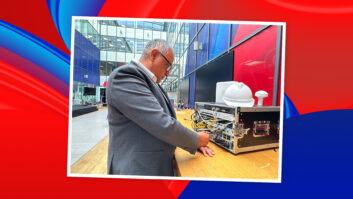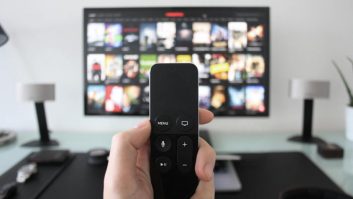Nevion is at the forefront of research into the opportunities 5G will offer broadcasters and OTT providers in the future. The company has been involved in two major projects: 5G Virtuosa, an EU-funded project exploring 5G and virtualisation in broadcast production, and 5G Verticals INNovation Infrastructure (5G VINNI) which is aiming to accelerate the uptake of 5G by providing an end-to-end facility to validate the performance of new 5G technologies.
According to Andy Rayner, chief technologist at Nevion, the company’s involvement in both projects is a cost-effective way of doing what he describes as the “horizon-based” or future base work in 5G technology. “Obviously there is funding involved which helps a relatively small company like Nevion in engaging in this work,” he tells TVBEurope. “Another key element for us is there are obviously lots of partners that we can work with in this space, both in the 5G provider space and the media related IP technology space, that allow us to actually do the best of breed trialling that’s pretty important to us.
“VINNI has got lots of tier one service providers from across Europe involved and Virtuosa, the project we’ve been leading ourselves, has enabled us to work with some extremely experienced media companies across Europe.”
Rayner says that Nevion has learnt a lot from both projects so far, which is enabling it to roadmap its own products. “While 5G is effectively being touted as already being available by some service providers, and there are some handsets that have got elements of 5G available, the elements that really provide the magic sauce for broadcast production are not really commercially available yet,” he explains. “So, what we are trying to do is actually test out and evaluate the capabilities that are going to bring real benefit for broadcast in advance of them becoming available on commercial offerings, both by service providers and other 5G equipment portfolio people. What we’re trying to work out is how that integrates with a best of breed workflow.”
We’ve all been talking about 5G for quite a while now, but Rayner is quick to stress that what we’re currently calling 5G isn’t actually 5G. “Up until now, broadcasters have used what I call best efforts bonded 4G solutions, that’s kind of a standard part of the broadcaster’s toolkit. But it doesn’t really address the full flexibility and requirements that we’re looking to for the future for broadcasting,” he says.
The production possibilities
Rayner adds that one of the challenges broadcasters could face in terms of a 5G infrastructure is that some of the technology required for flexibility in broadcast is reliant on service providers also seeing it as a viable element to make available within their portfolio of offerings. “One of the specific areas for broadcast that we’re hopeful about is what we call quality of service,” he explains. “That’s the concept where in 5G there is the potential of what’s called network slicing, you can define a network slice and the parameters in which that network slice operates and the quality of service. That means you’ll be able to achieve something you would have never been able to achieve on any wireless connectivity to date. And that’s a guarantee of bandwidth.”
That guarantee is key for new broadcast techniques such as remote production. Rayner believes the dream for broadcasters is the ability to arrive at an event with a number of cameras and microphones, and that’s it – you’re on air. “You can do it all through a remote gallery. Suddenly, lots of things become viable for broadcasters that haven’t been viable before. And that’s a key thing,” he says. “Where a broadcaster wouldn’t have dreamt of doing multi camera coverage of an event, if they can literally roll up 30 minutes before with half a dozen cameras, everything’s completely self contained over wireless internet, that’s an immensely powerful proposition.” Rayner adds that he can see 5G helping to democratise the process of broadcast production as 5G is much cheaper to work with than satellite or fibre.
In terms of distribution, Rayner says there are areas of 5G that need to be differentiated. One is the bandwidth, reach and latency of download-based media which 5G makes much easier. “I think there are two tenets of 5G that are important for what I call linear consumption,” he continues. “One of those is the concept of some of the recent advances in the technology toolkit of 3G PP, allowing effectively proper broadcasts – many consumers of the same stream, which obviously is a significant departure from the traditional mobile infrastructure requirement.
“I think a lot of people are seeing 5G as possibly the replacement of digital terrestrial television transmission in general. If you talk to key broadcasters in the UK as well as other countries, broadcasters are looking to internet-based delivery as the main channel to the consumer in the next 10 years. Digital satellite, digital terrestrial, digital cable, whilst they are the main tenets of getting to our key audience at the moment, they are going to diminish significantly. There will still be requirements for efficient multicast to consumers and the use of the 5G technology toolkit outside of the service provider offering of 5G is something that’s of interest to broadcasters in that space.”
So, when does Rayner think 5G will actually become mainstream? “In terms of the download consumption of media, and everyone’s that’s providing OTT delivered content in whatever way, that’s going to be ramping up throughout this year significantly. Even though the underlying backbone technology that’s providing that is really 4G Plus, rather than a pure 5G tech backbone.
“That’s distinctly different to what my vision is for broadcast contribution over 5G, because that’s relying on some of these more nuanced areas of the tech being evolved as part of the 5G suite, and those are not mass consumer requirements, they’re bespoke requirements,” continues Rayner. “Being realistic for the ‘dream’ of broadcast contribution, that area is probably two to three years away, even though we can start leveraging the enhanced bandwidth already.”
A glimpse of the future
Nevion has been working a lot with Sony (which, since we spoke, has taken ownership of the company). “I think they’ve got upwards of 10 different cameras now that have got built-in 4G technology as part of the camera. Those cameras are already capable of doing both streaming but also file upload capability, and those kinds of elements of technology will obviously benefit from having a 5G front-end,” says Rayner.
“Last autumn, Sony released a Cloud-based vision switcher that’s actually fully integrated with their radio cameras and to me that’s actually one of the most exciting glimpses of the future, because it’s a Cloud-based production environment you can run just from a browser on your laptop or your tablet,” he adds. “It’s radio cameras that are already enabled, they’re pushing back into a Cloud-based infrastructure so you don’t need any hardware at all as a broadcaster. To me that’s kind of a real glimpse of where we may be heading and obviously as the tech evolves, we will be able to do that kind of work on a more expensive scale, at an even higher quality, with even more features.”
Does that then mean that fibre and satellite have had their day? “Well, that’s very controversial,” laughs Rayner. “I think for delivery to the consumer there’s going be a mixed model for a long time, and I think 5G will become more and more pervasive within that. At the moment, most people want to consume a few 10s of megabits per second at home, and by far the most reliable, and even affordable way, of doing that has been by some kind of physical connectivity be that a DSL, or cable service or whatever. And I guess for a long time to come, if you’re fixed at home then probably some kind of fixed infrastructure is still going to be a good way to do that.
“What I think we are going to see is more of a seamless blend of the way you consume content. So I think the concept that your devices are automatically using either mobile bandwidth or internet will become more of a behind the scenes blend in terms of the data delivery.”
Rayner adds that there is certainly potential for 5G to oust traditional infrastructure for outside broadcast – in particular SNG. “If you look at broadcasters outside 10 Downing Street, the pop-up locations for plugging into the wall to get video back into the infrastructure for broadcasters, those kind of things may well disappear once we have a reliable and consistent enough broadcast capable infrastructure on 5G, but that does rely on some of these bells and whistles being available because we need to move from a best efforts world to a guaranteed world.”







